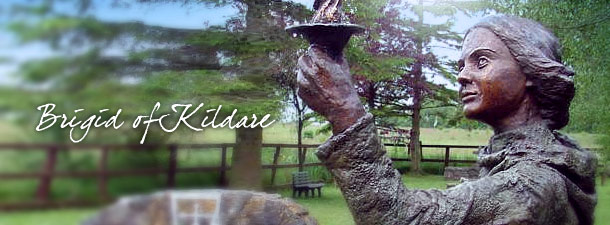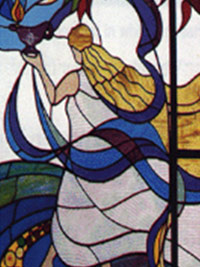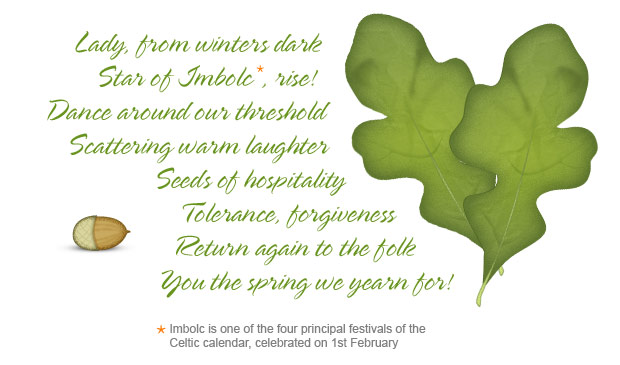Our Patroness – St. Brigid of Kildare c.452-525
Brigid of Kildare is a patroness of those who have a care for the earth, for justice and equality, for peace and reconciliation. She is a model for a contemplative life.
A great resurgence of interest in all aspects of our Celtic heritage is leading many individuals and groups to rediscover – and draw inspiration from – the lives of the early Irish saints. St. Brigid, the patroness of Ireland, is emerging as one whose life has relevance and inspiration, especially as we try to face the issues that confront our world at this time. When we look at the life of Brigid and at some of these issues we can see more clearly why she continues to be relevant today.

Carer of the Earth
The feast of St. Brigid on 1st of February is a celebration of the wonderful springing back of the earth from its winter sleep in the Northern Hemisphere. It is the season when we celebrate new beginnings and new life on earth. The sod is turned. The day lengthens. Seeds are sown and sails are hoisted.
Many of the stories about Brigid tell of her milking the cows, churning the milk, making up the firkins of butter, shepherding her flocks of sheep, helping with the harvest and even brewing the ale!
Brigid, in keeping with her Celtic tradition, was wonderfully attuned to the seasons and cycles of nature. She valued the elements of nature: earth, air, fire and water.
Healing Woman
We are aware of the fragility of our planet; bare and barren lands, polluted air, poisoned waters, damaged ecosystems and the threats these present to humans and other species.. Many individuals and groups concerned about the environment draw inspiration from the reverence and respect which Brigid had for the land. She is often referred to as the saint of agriculture.
The Irish monk, Cogitosus who wrote ‘A Life of Brigid’ (Vita Brigitae) in 650 AD, places great emphasis on Brigid’s faith, her healing powers, her hospitality, her generosity, her great skill with animals, and above all her compassion for the poor and the oppressed. Twenty three of the thirty two chapters relate her extraordinary concern for the poor.
The following legend of Brigid illustrates many of her qualities.
Woman of Compassion
One day when Brigid was on a long journey she stopped to rest by the wayside. A rich woman heard about this and brought her a beautiful basket of choice apples. No sooner had she received them than a group of very poor people came by and begged her for food. Without a moment’s hesitation, Brigid gave them the choice apples. The rich woman complained to Brigid, ‘I brought those apples for you, not for them.’ Brigid’s reply was: ‘What is mine is theirs.’
This Brigid legend poses a challenge to us to work for a more equitable distribution of the world’s resources, a challenge to a world where thousands die daily from hunger or hunger-related diseases or lack of clean water. Some 20% own and consume about 80% of Earth’s resources. The poverty gap continues to widen both within and between countries.
Model of Equality
It is generally accepted that Brigid established her abbey and church in Kildare c.470, on the site now occupied by St Brigid’s Cathedral. Brigid held a unique position in the Irish Church and in the society of her day. As Abbess, she presided over the local Church of Kildare and was leader of a double monastery for men and women.
Tradition suggests that she invited Conleth, a hermit from Old Connell near Newbridge, to assist her in Kildare. Cogitosus says: “they governed their Church by means of a mutually happy alliance.”
What emerges from many of these stories and legends about Brigid is the portrait of a strong and gentle woman, a powerful leader, a good organiser, a skilful healer and a wise spiritual guide. Brigid has become – for men and women – a potent symbol of Christian womanhood and the feminine face of God.
Woman of peace
There was no lack of domestic strife in Ireland in Brigid’s time. Feuds between clans were commonplace. She is often depicted as a peacemaker who intervened in disputes between rival factions and brought healing and reconciliation. Folklorists tell us that in some parts of Ireland a Brigid’s cross was often used as a token of goodwill between neighbours, indicating a desire for peace and friendship after a local quarrel.
One of the best-known stories associated with St Brigid is that of her giving away her father’s precious jewelled sword to a poor man so that he could barter it for food to feed his family. Thus, a sword, a weapon of war, was transformed into a life-giving instrument, turning a ‘sword into a ploughshare.’ This story offers an important lesson for today when millions of dollars are spent on weapons of war.
Woman of contemplation
Brigid emerges as a woman of action in the stories, legends and poems about her. If however, one were to seek the source from which she drew her strength and energy, one could probably find the answer in this story.
One day, St. Brendan the Navigator stood on a cliff top and watched two whales engaging in fierce combat. Suddenly, the smaller whale, in a human voice, cried out for help, not to Brendan but to Brigid who was not even present. The cry was answered immediately, and the combat ceased. Brendan was puzzled as to why he had been ignored.
An old Irish poem, written in the seventh century, speaks of her contemplation of the Trinity:
“Deeper than the seas
Greater than words can express
Three persons in one only God
Overflowing with wonder.”
Woman of inspiration
Even today poets, writers and artists still find inspiration in the symbols, customs and folklore surrounding Brigid. One writer referred to her as: “the woman who, above all others, embodies the spirit of pre-Christian and Christian Ireland.” P.J Brophy (Nenagh Guardian).
In a beautiful leadlight window in Kildare College Chapel, Holden Hill, South Australia the artist depicts Brigid dancing the dance of the new life of creation, carrying the Spirit of Jesus into the twenty-first century.

By Gail Donovan
Many of the values associated with Brigid are captured in this delightful poem:

Brigid died at Kildare on 1st February 525. She was laid to rest in a jewelled casket at Cill Dara. In 835, her remains were moved from Kildare to protect them from Norse invaders. She was interred in the same grave that holds the remains of St Patrick and St Columcille at the Cathedral grounds in Downpatrick. There are different spellings to her name – Brigit, Bridget, Bríd, Bride. She is also known as “Mary of the Gael.” (Mary of the Irish). Brigid’s feastday is on 1st February.
So strong is the respect and reverence for this holy woman that she is the patroness of many parishes, towns and counties, not only in Ireland but across Europe, America, Australia and New Zealand. Brigid’s cross is universally recognised. It became the logo for RTÉ (Ireland’s National Broadcasting TV station) when it first went on air in 1961 and remained its recognised symbol for many years.
Féile Bride (Brigid’s Festival)
Féile Bride is a week- long series of events commencing on 31st January, the eve of St. Brigid’s Day at Kildare, Ireland. The Feile incorporates a candle-lit pilgrimage on the eve of Brigid’s Day, a walk in the “Footsteps of Brigid of Kildare” as well as weaving of crosses and retelling of Brigid legends. The customs associated with Brigid are celebrated. Artists entertain pilgrims in a feast of poetry, music, song and ceili (Irish dancing.)
Féile Bride incorporates a peace and justice conference in collaboration with Afri (Action from Ireland) workshops, and the candle-lit ritual pilgrimage to Brigid’s Well. Brigid crosses are woven by young and old. The celebration of Eucharist and other creative rituals are conducted in the local churches.
To find out more follow one of the links below:
